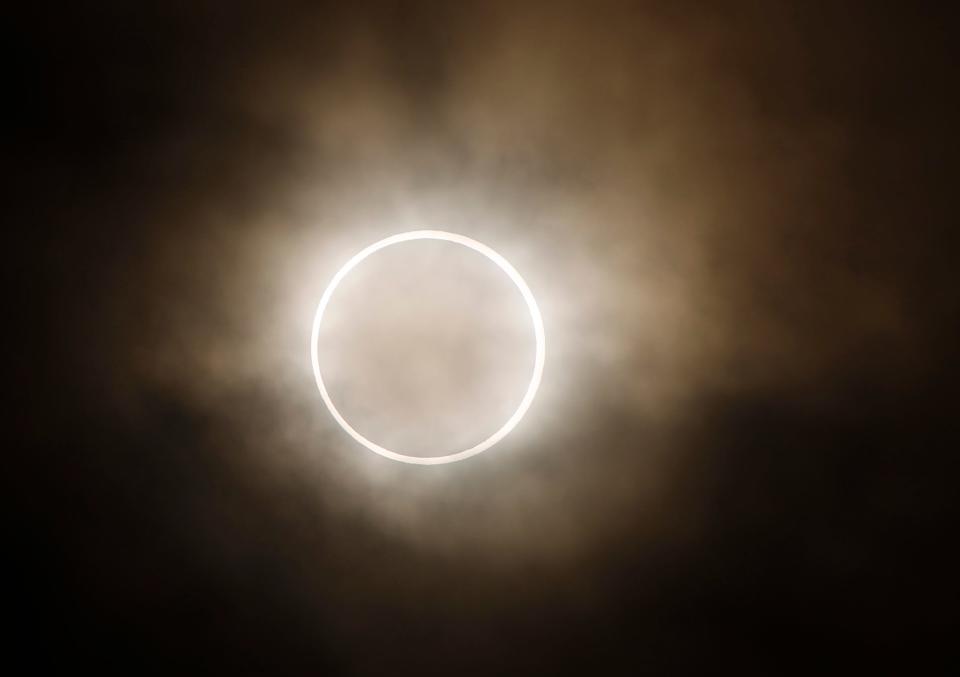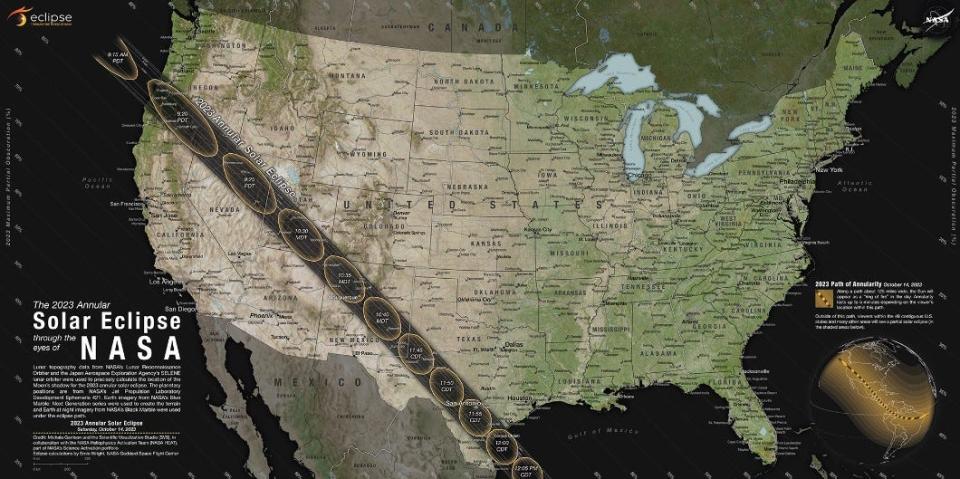Will we be able to see the solar eclipse in Rhode Island? What the forecast says
There's a solar eclipse on Saturday, but will anyone in the slice of Earth that is Southern New England notice?
The weather might not cooperate, as clouds could obscure the sun as they have on so many recent weekends.
Will we be able to see the solar eclipse in Rhode Island?
Over the United States, the path of the moon's shadow will run from Oregon to Texas, and Rhode Island will get only a partial eclipse, but Scott MacNeil, director of the Frosty Drew Observatory & Science Center in Charlestown, says it will be a good show if clouds don't ruin it.
"Even though we will only experience a 19.11% partial eclipse, it will still be a fantastic view to be had, especially since the sun is closing in on solar maximum – the period of the 11-year solar cycle with maximum sunspot activity," MacNeill wrote in his column on the observatory's website. "So keep your fingers crossed for a break from the weather bomb of 2023 so we can enjoy an autumn Saturday out under the sun."
More: Solar eclipses will be visible in Rhode Island in 2023 and 2024. Here's what to know

Saturday's solar eclipse is an annular eclipse – what that means
Saturday's eclipse is called an annular eclipse because it will happen when the moon is at the farthest point in its orbit from Earth and won't completely block the sun, instead causing a "dramatic 'ring' effect ... as the bright edge of the sun will be visible around the black silhouette of the moon," according to the Night Sky Network.
"The distinct appearance of this style of eclipse is why it’s called an annular eclipse, as annular means ring-like," the Night Sky Network wrote. "If you are standing under a tree or behind a screen you will see thousands of ring-like shadows projected everywhere during maximum eclipse, and the light may take on a wan note, but it won’t actually get dark outside; it will be similar to the brightness of a cloudy day."
RI weather forecast for the Oct. 14 solar eclipse – clouds likely
As of Friday, the weather forecast was calling for mostly cloudy skies with a chance of rain. MacNeill and other sky watchers are hoping that forecast improves. After all, he wrote, the observatory plans to host an event for the eclipse "which will bring the buzz of solar telescopes, live streams, presentations and more to our campus for the day."
Ways to watch the solar eclipse
Frosty Drew is planning to hold a viewing event from 10 a.m. until 3 p.m., which is open to the public. The eclipse starts at 12:15 p.m. Saturday and will continue until 2:35 p.m. with maximum eclipse at 1:26 p.m. when the moon will obscure 19.11% of the sun over Southern New England, MacNeill wrote.

Tickets are required for the Frosty Drew event and cost $5. (Children 4 and under are admitted for free.) The ticket price includes a pair of eclipse glasses. Experts emphasize that it isn't safe to view the eclipse without proper eye protection.
Another Rhode Island observatory, Seagrave Memorial Observatory in North Scituate, will be open for viewing from 11:30 a.m. until 3 p.m. Saturday, if the weather permits, according to Linda Bergemann, president of Skyscrapers Inc., which operates the observatory.
No formal program is planned, but members will be at the observatory with eclipse glasses for anyone "who happens to pay us a visit," she said. There's no charge.
In addition, the Museum of Natural History and Planetarium at Roger Williams Park in Providence will host activities where the family can learn about eclipses and also receive a pair of eclipse glasses. The event is from 10 a.m. until 4 p.m. and is free with museum admission.
At the Community College of Rhode Island, operators of the Margaret M. Jacoby Observatory are taking a wait-and-see approach.
"The current forecast seems to suggest it will not be possible to observe, but we will mobilize and show up if the conditions change," said Brendan Britton, associate professor of astronomy.
""If the skies suddenly clear up, a group of us will be there from 12-2:30 p.m. Saturday to view the eclipse, and members of the public are welcome to join," Britton said via email late Tuesday.
How to make eclipse glasses
Can I look directly at the eclipse?
According to NASA, it is never safe to look directly at the sun during an annular eclipse without specialized eye protection as you could permanently damage your eyes.
When watching an annular (or even partial) solar eclipse people should always look at it using approved solar viewing glasses (AKA eclipse glasses) or a handheld solar viewer.
How to make a do-it-yourself eclipse viewing projector
Here's how to safely make an eclipse viewer and how to use it:
Get cardboard box, a white sheet of paper, tape, scissors, and piece of aluminum foil.
Punch a pinhole into the aluminium foil.
Tape it over one side of the box.
Tape the white sheet of paper to the inside of the other side of the box.
Stand with the sun behind you.
Light will stream through the pinhole and project a crescent sun onto the white sheet of paper in the box.
Look into the box through another hole you cut into the box to see the projected image.
Do not look at the sun through the pinhole
How long can you look at the eclipse without glasses?
You can view the eclipse for a short period of time without glasses.
But only during the period known as totality − when the sun is completely covered by the moon.
Depending on where you are, the totality could last about four minutes, according to NASA
As soon as even a tiny slice of the sun reappears after totality, NASA says, put your eclipse glasses back on or use your handheld solar viewer to relook at it.
Additional tips for viewing an eclipse:
Additional tips for safely viewing an annular eclipse include:
Inspect eclipse glasses or handheld viewers before using them. Throw them away if they are torn, scratched, or damaged.
Instruct children how to properly watch the eclipse.
Supervise children using eclipse sunglasses or handheld solar viewers.
Total solar eclipse will happen on April 8, 2024
If Saturday's eclipse does get blocked out, residents of Southern New England won't have to wait too long for another chance to witness such a spectacle. A total solar eclipse will cross North America on April 8, 2024, and with the path of totality nearby, it will create a much darker show in this area, obscuring about 90% of the sun over Southern New England, according to Bergemann.
That is, if the clouds don't get in the way.
– With reports from USA TODAY
This article originally appeared on The Providence Journal: RI weather forecast: Will clouds ruin view of weekend solar eclipse?

